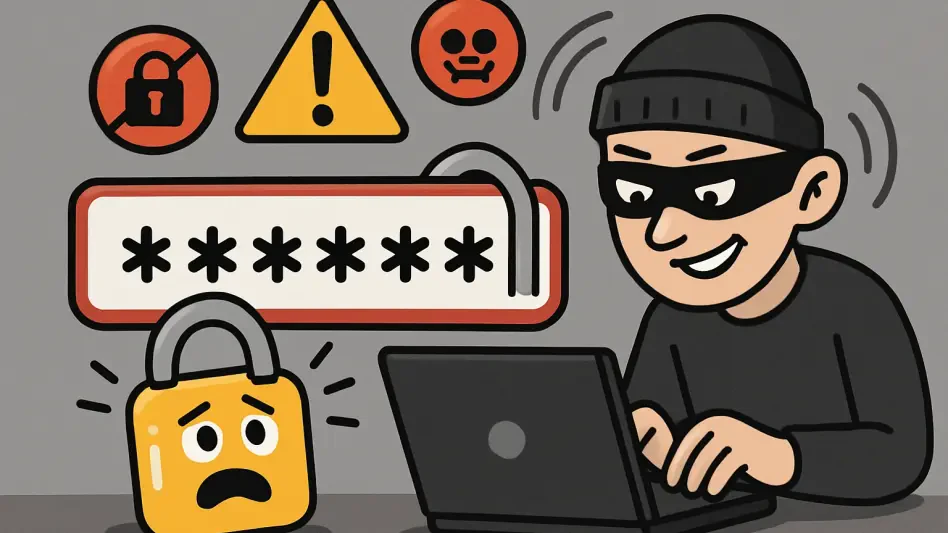Password security is a critical component of online safety for both individuals and organizations. Despite growing awareness about cybersecurity, many users still rely on weak passwords and risky practices, which leaves them vulnerable to threats. The modern digital landscape, teeming with advanced cyber threats, demands a higher standard of password protection and vigilance.
The Disheartening Reality of Weak Passwords
Alarmingly Common Password Choices
A significant portion of users continues to employ easily guessable passwords, undermining efforts to bolster cybersecurity. Simple and predictable combinations like “123456” are still frequently used, which is shocking given the plethora of available advice and tools to create stronger passwords. Such choices leave users alarmingly exposed to even the most rudimentary hacking attempts. The continued prevalence of these weak passwords highlights a disconnect between cybersecurity knowledge and user habits.
Weak passwords provide an easy entry point for attackers, and their widespread use suggests that there is much work still to be done in terms of educating people about the risks. Users often opt for convenience over security, choosing passwords that are simple to remember rather than robust against attacks. This trend is particularly concerning given the increasing frequency and sophistication of cyber threats. The use of common passwords negates the benefits of more complex security measures in place.
The High Cost of Ignorance
Weak passwords contribute significantly to data breaches, an issue that costs companies millions annually. The financial repercussions of a breach are staggering, encompassing not only direct monetary losses but also reputational damage and loss of customer trust. Even passwords that ostensibly meet basic complexity requirements can fall prey to hackers due to predictable patterns or slight variations on commonly used passwords.
The ignorance surrounding password complexity extends beyond individual users to corporate environments, where adherence to strong password policies is often inconsistent. Companies are continually advised to implement stringent password policies and to educate their employees about the dangers of weak passwords. However, the implementation of these policies does not always translate into action. Organizations must understand that investing in robust password protocols is not merely a compliance issue but a critical component of their operational security.
Danger of Password Reuse
Prevalence of Repeated Passwords
Despite widespread knowledge of the risks, many individuals continue to reuse passwords or slight variations across multiple accounts. This practice makes them easy targets for cybercriminals conducting credential stuffing attacks, where stolen credentials from one breach are used to gain unauthorized access to other accounts. The temptation to reuse passwords arises from the sheer number of accounts most people manage, leading them to prioritize convenience over security.
The reuse of passwords creates a fragile security environment, where the compromise of a single password can lead to multiple account breaches. Cybercriminals capitalize on this common practice, knowing that a successful login with reused credentials can open doors to a plethora of personal and sensitive information. The variability in password strength across different accounts exacerbates this risk, as users may employ robust passwords for critical accounts but overlook weaker passwords in less frequently used services.
The Domino Effect of Breaches
When a user’s password is compromised on one account, it can potentially compromise multiple accounts, leading to a cascading failure of security. The interconnected nature of digital accounts means that a single breach can have far-reaching consequences. For instance, a compromised email account can provide access to numerous linked services, including banking, social media, and workplace accounts, each containing valuable and sensitive information.
This domino effect underscores the importance of maintaining unique passwords for each account. Once attackers gain access to one account, they can leverage personal information found within to breach additional accounts linked to the individual. The fallout from such breaches can be catastrophic, leading to identity theft, financial loss, and considerable emotional distress. Users must recognize that password reuse is akin to leaving multiple doors open for intruders; it significantly undermines the overall integrity of their digital security.
Impacts and Statistics of Password Hacking
Financial Toll on Businesses
Data breaches due to weak passwords have significant financial consequences, with costs rising year over year. The financial impact is not just about the direct costs of the breach but also encompasses fines, legal fees, and operational disruptions. Businesses face substantial financial challenges in the aftermath of a data breach, as they must allocate resources to mitigate damage, restore systems, and reassure stakeholders.
The costs associated with data breaches are amplified when considering the long-term effects on business operations and customer trust. Companies affected by breaches often experience a decline in market value and customer loyalty. The resources required to recover from a breach can also divert attention and funds from strategic initiatives. As the financial burden of weak passwords becomes increasingly apparent, it is vital for businesses to enhance their password security measures and foster a culture of cybersecurity awareness among employees.
The Human Element
Incidences of hacking not only have financial impacts but personal ones as well, affecting everyday users through compromised emails and social media accounts. When personal accounts are hacked, individuals often suffer from more than just financial loss; they endure emotional distress, privacy violations, and reputational damage. The erosion of trust can be particularly devastating, especially when private conversations and sensitive personal data are exposed.
The human element of password hacking highlights the broader implications for societal trust in digital services. Users who fall victim to breaches may become wary of online transactions and services, impeding the growth of digital economies. Furthermore, the psychological toll of identity theft and the effort to reclaim one’s digital life can be immense. This personal suffering underscores the need for robust security practices and the development of more user-friendly authentication methods that do not compromise security.
Adoption of Password Managers
Gradual Increase in Adoption
There has been a slow rise in the use of password managers, which help users generate and store strong, unique passwords. These tools are designed to alleviate the burden of remembering multiple complex passwords, thereby enhancing overall security posture. Although their adoption is increasing, there remains a significant portion of the population that is either unaware of or reluctant to use these tools. Education and awareness campaigns are crucial in promoting the benefits of password managers.
The gradual increase in the usage of password managers signifies a positive shift towards better security practices. Users of password managers can generate unique, complex passwords for each account, reducing the risk of password reuse and weak passwords. However, overcoming skepticism about the security of password managers themselves is an ongoing challenge. Continuous technological improvements and assurance regarding the security of these tools are essential to broaden their adoption.
Benefits of Password Managers
Users of password managers experience fewer instances of identity theft and overall are more secure in their online endeavors. These tools not only generate robust passwords but also store them securely, allowing users to access their accounts without the need to memorize myriad complex passwords. Password managers also offer features such as password strength assessments and alerts for compromised accounts, further bolstering security.
The benefits of password managers extend beyond individual users to corporate environments, where they can enforce strong password policies and simplify password management across the organization. By automating password creation and storage, password managers reduce the likelihood of security lapses due to human error. As more users and companies recognize these advantages, the role of password managers in safeguarding digital security becomes increasingly pivotal. Their implementation can serve as a foundational step toward a more secure digital presence.
Industry-Specific Password Practices
Vulnerable Sectors
Certain industries such as construction and healthcare exhibit particularly poor password practices, increasing their risk of cyberattacks. The construction industry, noted for its high percentage of reused and weak passwords, presents significant vulnerabilities. Similarly, the healthcare sector, despite handling sensitive patient data, often falls short in implementing strong password policies, thereby exposing critical information to cyber threats.
These vulnerable sectors often face unique challenges that contribute to poor password practices. The construction industry, with its mobile workforce and multiple contractors, struggles with consistent security measures across projects. Healthcare providers, meanwhile, balance the need for quick access to information with stringent privacy regulations, sometimes at the expense of robust password security. Addressing these industry-specific challenges requires tailored solutions that consider their operational realities while reinforcing security protocols.
Better Practices in Secure Sectors
Some sectors, like energy and utilities, have stricter security measures, resulting in fewer compromised passwords. These industries typically implement stringent cybersecurity protocols due to the critical nature of their operations and the potential consequences of a breach. Their adherence to robust password practices, such as enforcing strong, unique passwords and regular security audits, serves as a model for other sectors struggling with similar issues.
The success of these secure sectors lies in their comprehensive approach to cybersecurity, which includes employee training, regular updates of security measures, and the use of advanced authentication technologies. By prioritizing cybersecurity, these industries not only protect their operations but also set a benchmark for other sectors to follow. Their commitment to continuous improvement and adaptation to emerging threats demonstrates the importance of proactive security strategies.
Company Size and Password Security
Small Business Risks
Small businesses often have the highest rates of compromised passwords due to a lack of robust security protocols and resources. Limited budgets and smaller IT teams can hinder the implementation of comprehensive cybersecurity measures, making these businesses attractive targets for cybercriminals. The reliance on simple, easily guessable passwords is more pronounced in smaller businesses, which may lack the expertise to enforce stronger password policies.
The risks associated with weak passwords in small businesses are compounded by the interconnected nature of their operations. A breach in one area can quickly escalate, affecting partners, clients, and vendors. Raising awareness and providing affordable cybersecurity solutions tailored to small businesses are essential steps in mitigating these risks. By investing in even basic security measures, small businesses can significantly enhance their resilience against cyber threats.
Midsize and Enterprise Security
Midsize businesses fare better in password security, with more resources to dedicate to cybersecurity initiatives and stronger password policies. These organizations are often more aware of the risks and have implemented measures to enforce good security practices among their employees. Regular training and the use of advanced security tools help these businesses maintain a robust security posture against potential threats.
Large enterprises, while having more resources, find themselves somewhere in the middle due to the sheer complexity and scale of their operations. Managing password security across a large workforce and multiple systems poses unique challenges, requiring sophisticated solutions and continuous oversight. Enterprises must balance security with usability, ensuring that policies are not only effective but also practical for their employees. The implementation of centralized security management systems and periodic security audits are critical in maintaining the integrity of their password security.
Common Mistakes and Trends
Persistent Risky Behaviors
Many users continue to store passwords insecurely or rely on memorization, which perpetuates vulnerability. The practice of writing passwords down, using browser storage, or maintaining easily guessable passwords exposes users to considerable risk. Despite the availability of secure password management tools, there remains a significant portion of the population that clings to these risky behaviors.
The reasons behind these persistent risky behaviors vary, but common factors include convenience, lack of awareness, and resistance to change. Users may not fully understand the risks involved or may underestimate the likelihood of becoming a target. Overcoming these behaviors requires a concerted effort to educate users about the dangers and to promote the adoption of more secure practices. Technological solutions that simplify password management without compromising security can also encourage better habits.
Prioritization of Security
Despite the risky behaviors, there is a trend towards prioritizing security over convenience, especially with the advancement of multi-factor authentication. Multi-factor authentication adds an extra layer of security by requiring users to provide two or more verification factors to gain access to a resource, reducing the reliance on passwords alone. This growing trend indicates a positive shift towards more secure authentication methods.
The adoption of multi-factor authentication is becoming increasingly common as users and organizations recognize its benefits. By making it more difficult for attackers to gain unauthorized access, multi-factor authentication enhances overall security. This trend reflects a broader awareness of cybersecurity risks and a willingness to adapt to more secure authentication methods. As the adoption of these technologies continues, it is expected that reliance on traditional passwords will diminish, further strengthening digital security.
Practical Tips for Enhanced Security
Creating Strong Passwords
Users should create strong, unique passphrases and avoid predictable patterns to strengthen their passwords. Passphrases, which combine random, unrelated words, can be easier to remember while providing robust security. Incorporating special characters, numbers, and varying the case of letters can add complexity, making passwords harder to guess or crack. Avoiding linear and predictable keyboard patterns also strengthens password security.
Using different email addresses for sensitive accounts adds another layer of protection. This practice ensures that even if one account is compromised, other critical accounts remain secure. Additionally, users should regularly update their passwords and avoid reusing them across multiple accounts. Creating and maintaining strong passwords is a fundamental step in fortifying one’s digital security against cyber threats.
Utilizing Advanced Tools
Adopting tools like password managers and enabling two-factor authentication offers an additional layer of security. Password managers can generate and store complex, unique passwords, alleviating the burden of remembering them. They also provide features like password strength assessments and alerts for compromised passwords, enhancing overall security. Enabling two-factor authentication adds an extra layer of verification, making it significantly more challenging for attackers to gain unauthorized access.
The combination of strong passwords and advanced security tools creates a robust defense against cyber threats. Users who leverage these tools can significantly reduce their vulnerability to attacks. Continuous education and awareness about available security tools and practices are essential in promoting their widespread adoption. By integrating these advanced tools into their daily digital interactions, users can create a more secure online environment.
Future Considerations for Enhanced Security
Password security is a crucial aspect of maintaining online safety for individuals and organizations alike. Despite the increasing awareness of cybersecurity, a significant number of users continue to use weak passwords and engage in risky online behaviors. These practices make them susceptible to cyber threats such as hacking, identity theft, and unauthorized access to sensitive information.
In today’s digital world, which is filled with sophisticated cyber threats, it is essential to adopt a more robust standard for password protection. Simple passwords like “123456” or “password” are easy targets for hackers. Strong passwords should be a mix of upper and lower case letters, numbers, and special characters, making them harder to crack. It’s also recommended to avoid using easily guessable information such as birthdays or pet names.
Furthermore, changing passwords regularly and using different passwords for different accounts can enhance security. Employing two-factor authentication (2FA) adds another layer of protection by requiring a second form of verification in addition to the password. Password managers can also aid in generating and storing complex passwords securely.
The increasing frequency of data breaches underscores the importance of strong password practices. By prioritizing password security, individuals and organizations can protect themselves against the ever-present and evolving cyber threats in our digital age.








